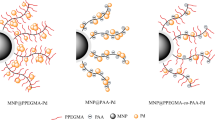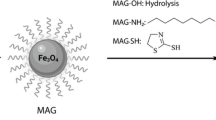Abstract
Magnetic nanoparticles (MNPs) modified by polyamidoamine (PAMAM)-immobilized 2,2,6,6-tetramethyl-1-piperidinyl-oxyl (TEMPO) as recoverable catalysts for catalytic oxidation of polyethylene glycol were designed and prepared, which were expected to combine the advantages of easy recovery of MNPs and high activity of PAMAM-immobilized TEMPO. The catalysts of MNPs modified by PAMAM-immobilized TEMPO (MNPs-PAMAM-T) were characterized by Fourier transform infrared spectroscopy (FT-IR), thermal gravimetric analyzer (TGA), and transmission electron microscopy (TEM). The mean particle size of MNPs was about 10 nm. MNPs-PAMAM-T/NaBr/NaClO was used as catalytic system for catalytic oxidation of monomethoxy poly (ethylene glycol). The catalytic performances were affected by the loading amounts of TEMPO and PAMAM generations. It was shown that the catalyst with TEMPO loading of 5.198 mmol/g using G2.0 PAMAM-modified MNPs as carrier had the best catalytic performance, which could be up to 94% of the free TEMPO level. The efficient recovery of catalyst could be achieved by magnetic separation and the recycling performance was good.










Similar content being viewed by others
References
Araki J, Iida M (2016) Surface carboxylation of cellulose nanowhiskers using mPEG-TEMPO: its recovery and recycling. Polym J 48:1029–1033
Araki J, Zhao CM, Ito K (2005) Efficient production of polyrotaxanes from α-cyclodextrin and poly (ethylene glycol). Macromolecules 38:7524–7527
Beejapur HA, Zhang Q, Hu K, Zhu L, Wang J, Ye Z (2019) TEMPO in chemical transformations: from homogeneous to heterogeneous. ACS Catal 9:2777–2830
Bolm C, Fey T (1999) TEMPO oxidations with a silica-supported catalyst. Chem Commun 18:1795–1796
Chen P, Chen G, Zhao YQ (2015) A method for preparing terminal carboxylated polyethylene glycol. CN Pat. 104761716 A.
Chou CM, Lien HL (2010) Dendrimer-conjugated magnetic nanoparticles for removal of zinc (II) from aqueous solutions. J Nanopart Res 13:2099–2107
Christophe M, Daniel S, Michel B (2001) 2,2,6,6-Tetramethyl-1-piperidinyl-oxyl/[Bis (acetoxy)-iodo] benzene-mediated oxidation: a versatile and convenient route to poly (ethylene glycol) aldehyde or carboxylic acid derivatives. J Polym Sci A Polym Chem 39:4022–4024
Cui Y, Zhang J, Yu Q, Guo X, Chen S, Sun H, Liu S, Wang LG, Lai X, Gao D (2019) Highly biocompatible zwitterionic dendrimer-encapsulated platinum nanoparticles for sensitive detection of glucose in complex medium. New J Chem 43:9076–9083
Elouarzaki K, Mandoc LRP, Gorgy K, Holzinger M, Amarandei CA, Ungureanu EM, Cosnier S (2015) Synthesis and electrochemical characterization of original “TEMPO” functionalized multiwall carbon nanotube materials: application to iron (II) detection. Electrochem Commun 60:131–134
Gao BJ, Zhang LQ, Chen T (2015) TEMPO immobilized on polymer microspheres-catalyzed oxidation of cyclohexanol by molecular oxygen. Chin J Catal 36:1230–1236
Guo X, Zhang J, Cui Y, Chen S, Sun H, Yang Q, Ma G, Wang L, Kang J (2019) Highly biocompatible jujube polysaccharide-stabilized palladium nanoparticles with excellent catalytic performance. New J Chem 43:7646–7652
Hövelmann CH, Gooβen S, Allgaier J (2017) Scale-up procedure for the efficient synthesis of highly pure cyclic poly (ethylene glycol). Macromolecules 50:4169–4179
Huang J, Chen SF, Zeng T, Li JW (2007) Acid-Base titration applied in characterization of poly (amidoamine). Polym Mater Sci Eng 23:185–191
Karimi B, Farhangi E (2013) One−pot oxidative passerini reaction of alcohols using a magnetically recyclable TEMPO under metal− and halogen−free conditions. Adv Synth Catal 355:508–516
Karimi B, Biglari A, Clark JH, Budarin V (2007) Green, transition-metal-free aerobic oxidation of alcohols using a highly durable supported organocatalyst. Angew Chem Int Ed 46:7210–7213
Khodadust R, Unsoy G, Yalcin S, Gunduz G, Gunduz U (2013) PAMAM dendrimer-coated iron oxide nanoparticles: synthesis and characterization of different generations. J Nanopart Res 15:1488–1501
Khorramabadi-zad A, Daliran S, Oveisi AR (2013) Aerial oxidation of bisnaphthols to spironaphthalenones by a recyclable magnetic core-sell nanoparticle-supported TEMPO catalyst. CR Chim 16:972–976
Kim SY, Ha JC, Lee YM (2000) Poly (ethylene oxide)-poly (propylene oxide)-poly (ethylene oxide)/poly(ϵ-caprolactone)(PCL) amphiphilic block copolymeric nanospheres. J Control Release 65:345–358
Lewis LN (1993) Chemical catalysis by colloids and clusters. Chem Rev 93:2693–2730
Liu SJ, Hu QQ, Zhao FQ, Tang EJ (2014) Nitroxide polymer brushes prepared by surface-initiated ARGET ATRP and their selective oxidation performances. Express Polym Lett 8:862–868
Liu SJ, Chu XM, Wang HL, Zhao FQ, Tang EJ (2015) Preparation of nitroxide polymer brushes and their applications in the synthesis of an epoxidized soybean oil acrylate as an inhibitor. Ind Eng Chem Res 54:5475–5480
Liu SJ, Xing YB, Han JZ, Tang EJ (2017) Catalytic oxidation of cellulose with a novel amphiphilic nitroxide block copolymer as a recoverable catalyst. Cellulose 24:3635–3644
Liu SJ, Liang HZ, Sun TT, Yang DS, Cao M (2018a) A recoverable dendritic polyamidoamine immobilized TEMPO for efficient catalytic oxidation of cellulose. Carbohydr Polym 202:563–570
Liu SJ, Sun TT, Yang DS, Cao M, Liang HZ (2018b) Polyacrylic acid supported TEMPO for selective catalytic oxidation of cellulose: recovered by its pH sensitivity. Cellulose 25:5687–5696
Lv WQ, Geng C, Xu JW (2019) Ozonation of polyethylene glycol aldehyde derivatives. Chin J Appl Chem 36:120–122
Megiel E (2017) Surface modification using TEMPO and its derivatives. Adv Colloid Interface Sci 250:158–184
Pan BF, Gao F, Gu HC (2005) Dendrimer modified magnetite nanoparticles for protein immobilization. J Colloid Interface Sci 284:1–6
Patankar SC, Renneckar S (2017) Greener synthesis of nanofibrillated cellulose using magnetically separable TEMPO nanocatalyst. Green Chem 19:4792–4797
Schatz A, Grass RN, Stark WJ, Reiser O (2008) TEMPO supported on magnetic C/Co−nanoparticles: a highly active and recyclable organocatalyst. Chem – Eur J 14: 8262−8266
Shakir AJ, Paraschivescu C, Matache M, Tudose M, Mischie A, Spafiu F, Ionita P (2015) A convenient alternative for the selective oxidation of alcohols by silica supported TEMPO using dioxygen as the final oxidant. Tetrahedron Lett 56:6878–6881
Shylesh S, Schunemann V, Thiel WR (2010) Magnetically separable nanocatalysts: bridges between homogeneous and heterogeneous catalysis. Angew Chem Int Ed 49:3428–3459
Subhani MA, Beigi M, Eilbracht P (2008) Polyurethane-and polystyrene-supported 2,2,6,6-tetramethyl-piperidine-1-oxyl (TEMPO): facile preparation, catalytic oxidation and application in a membrane reactor. Adv Synth Catal 350:2903–2909
Tang J, Zhang Q, Hu K, Zhang P, Wang J (2017) Novel high TEMPO loading magneto-polymeric nanohybrids: an efficient and recyclable Pickering interfacial catalyst. J Catal 353:192–198
Tucker-Schwartz AK, Garrell RL (2010) Simple preparation and application of TEMPO-coated Fe3O4 superparamagnetic nanoparticles for selective oxidation of alcohols. Chem Eur J 16:12718–12726
Veronese FM (2001) Peptide and protein PEGylation: a review of problems and solutions. Biomaterials 22:405–417
Wan C, Chung Y, Toy PH (2007) Multipolymer reaction system for selective aerobic alcohol oxidation: simultaneous use of multiple different polymer-supported ligands. J Comb Chem 9:115–120
Wang YM, Song XY, Shao SH, Zhong HM, Lin F (2012) An efficient, soluble, and recyclable multiwalled carbon nanotubes-supported TEMPO for oxidation of alcohols. RSC Adv 2:7693–7698
Wang LY, Li J, Zhao XP, Lv Y, Zhang HY, Gao S (2013) An efficient and scalable room temperature aerobic alcohol oxidation catalyzed by iron chloride hexahydrate/mesoporous silica supported TEMPO. Tetrahedron 69:6041–6045
Yang C, Guenzi M, Cicogna F, Gambarotti C, Filippone G, Pinzino C, Passaglia E, Dintcheva NT, Carroccio S, Coiai S (2016) Grafting of polymer chains on the surface of carbon nanotubes via nitroxide radical coupling reaction. Polym Int 65:48–56
Yu YL, Gao BJ, Li YF (2014) Immobilized 2,2,6,6-tetramethyl-piperidinyl-1-oxy catalyst on polymer microspheres and its catalytic oxidation of benzyl alcohol with molecular oxygen. Chin J Catal 34:1776–1786
Zhao HL, Zhang ZG, Zhao ZJ, Yu RH, Wan YY, Lan MB (2012) Preparation and characterization of novel spin labeled magnetic nanoparticles. Adv Mater Lett 2:172–175
Zheng Z, Wang J, Zhang M, Xu L, Ji J (2013) Magnetic polystyrene nanosphere immobilized TEMPO: a readily prepared, highly reactive and recyclable polymer catalyst in the selective oxidation of alcohols. ChemCatChem 5:307–312
Zhu J, Wang PC, Lu M (2012) Synthesis of novel magnetic silica supported hybrid ionic liquid combining TEMPO and polyoxometalate and its application for selective oxidation of alcohols. RSC Adv 2:8265–8268
Funding
This study was supported by the Special Project of Local Science and Technology Development Guided by the Central Government of China (19941403G). Here, we expressed the heartfelt thanks for the support.
Author information
Authors and Affiliations
Corresponding author
Ethics declarations
Conflict of interest
The authors declare that they have no conflict of interest.
Additional information
Publisher’s note
Springer Nature remains neutral with regard to jurisdictional claims in published maps and institutional affiliations.
Rights and permissions
About this article
Cite this article
Sun, T., Liang, H., Liu, S. et al. Magnetic nanoparticles modified by polyamidoamine-immobilized TEMPO for catalytic oxidation of monomethoxy poly (ethylene glycol). J Nanopart Res 22, 163 (2020). https://doi.org/10.1007/s11051-020-04904-9
Received:
Accepted:
Published:
DOI: https://doi.org/10.1007/s11051-020-04904-9




